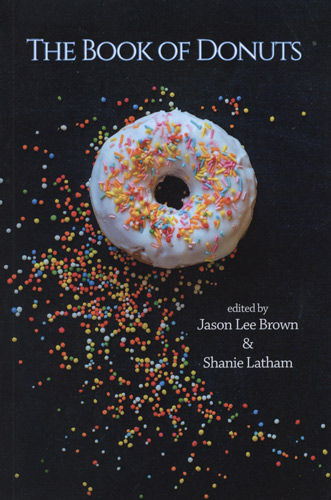The Book of Donuts
I’ve discovered that the donut is a popular topic for books, but I haven’t noticed an entire book of poems on the subject. The Book of Donuts, edited by Jason Lee Brown and Shanie Latham, helps fill in the gap. The editors have brought together several dozen diverse poets with equally diverse attitudes toward the confection.
I’ve discovered that the donut is a popular topic for books, but I haven’t noticed an entire book of poems on the subject. The Book of Donuts, edited by Jason Lee Brown and Shanie Latham, helps fill in the gap. The editors have brought together several dozen diverse poets with equally diverse attitudes toward the confection.
For example, see how Nancy Susanna Breen strikes a funny and familiar note in “Elegy for the Last Donut” when she writes:
Pity the poor donut no one took
[ . . . ] It languishes in its cardboard box
on the conference room table, gazing
hopefully through the cellophane lid
as the minutes tick away to quitting time.
In Faisal Mohyuddin’s “Afterwards,” even the donut toppings have feelings. He begins, “On the worst days, as I’m about to consume in secret / an entire assorted dozen while seated in my darkened kitchen.” He continues:
When there’s nothing left to sink
my shame into, I close my eyes, listen to my teeth sing,
lick the tip of my finger, and, in gentle jabs, search
the crumby tabletop for stray sprinkles, each hoping to be
found, eaten by a lonely someone who shares the pain of existing
on the glazed layer of someone else’s idea of perfection.
For a change of pace, Kim Lozano in “The Light on Everything” swerves from the standard donut to the land of honey buns. While on a campout:
The children discard their wrappers and proceed,
following an unspoken rule as sacred as a proverb, as
important to their lives as rock-paper-scissors and wishbones.
do not bite across coils
rather follow each ring
along its unwinding
Follow that with “Free Samples Field Trip,” in which Marjorie Maddox immortalizes her favorite, enjoyed in a similar setting as Lozano’s honey buns, the Boston cream:
Campfire Girls in the seventies,
we craved not log and flames,
tent and bags, [ . . . ] but
crullers, fritters, long johns, Boston creams
clicking, I-Love-Lucy style,
on too-quick conveyer belts
past our seventh-grade hunger
But all is not levity. To get a taste of the book’s more serious poetry, read “5 World Trade Center.” In it, James Penha’s perspective is from his current home in Indonesia as he watched TV on September 11, 2001, and was sadly reminded of the Krispy Kreme store he visited in his New York hometown:
though workers and customers escaped
unharmed and pictures surfaced later
showing trays of donuts waiting still to be told
where to go
Anne Sandor titles her piece “How Scientists Get Made, or How is a doughnut like a coffee cup?” Her poem reels around science, with a note at the end referring to the 2016 Nobel Prize winners in physics who answered the question, “How is a donut like a coffee cup?” I looked it up, and it’s worth a Google.
The police play a big part in Julian Stannard’s poem titled simply “Donut,” though not quite in the way readers may initially expect:
Suddenly America feels
different and I like it. Police
blotters throughout the nation
packed with donut-heads and half the country
on the run as college girls make
secret calls and meet their dealers
in dusty ghost towns, sweet
vapors drifting through the trees.
Elsewhere, Angela Villarreal Ratliff educates us in “Connecting Dots and Donuts”: “Every country has its doughnut: round or flat—filled, dipped, or braided. Greece has loukoumas. India has balushahi and gulgula.” Along with telling a family story, she fills us in on many more words in other languages for the sweet indulgence.
For more along that line, Dianalee Velie, in “Babci’s Apron,” writes about Polish donuts:
Pączki make me punchy,
send me yearning
for my grandmother’s
kitchen in Brooklyn,
[ . . . ] the joy of eating
jelly donuts
as fast as
they were made
But enough about eating these delicious treats. Time to poetically experience making and selling donuts. Heather Lynne Davis, who’s been there, done that, captures the mood in “In Praise of Donut Sellers”:
After several months,
you realize how deeply you hate
the flippin’ donuts, the bakery, that
fecund, yeasty smell, the thick caul
of grease and powdered sweetness
melded to your skin.
Denise Duhamel follows suit in “Mr. Donut.” She zeroes in on men who “tumble from closing bars” into the donut shop. She writes:
What a way to save to go to Europe.
But that’s what I’m doing,
the donut waitress taking advantage
of drunks.
It’s not all bad, however, because “they all leave big bills under the saucers / and I get to read the few / quiet hours before dawn.”
No matter whether you spell it donut or doughnut, The Book of Donuts is a delight to read. Adding to the pleasure, the author and public radio personality Grace Cavalieri wrote the introduction to the book that includes a nice surprise: a donut recipe.





